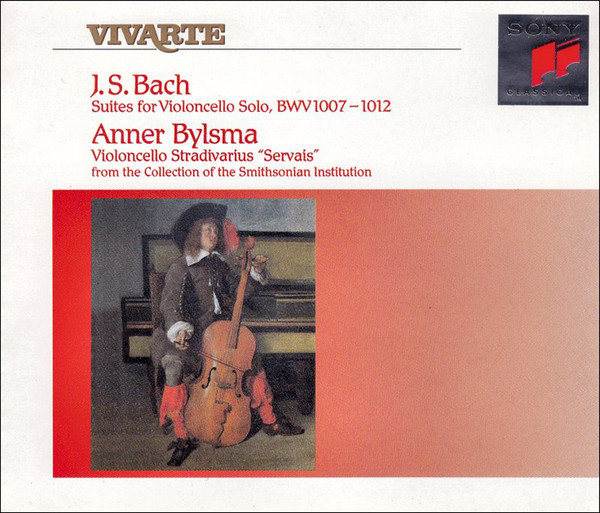
Anner Bylsma Bach Cello Suites Sony Classical S2K48047 Release year 1992
Recorded at the American Academy of Arts and Letters New York January 29-31 1992.
For this DDD recording, 20-bit technology was used for “high definition sound.”
In Suites 1-5 Bylsma plays the Servais Stradivarius cello 1701 loaned by the Smithsonian Institution.
For the 6th Suite he plays a violoncello piccolo Tirol ca 1700 anonymous with baroque bow.
General comments.
Firstly, I have to report that the Servais Stradivarius leaves its sound print all over this recording. The excellent booklet goes into some detail as does a commentary by Bylsma.
Essentially, this particular cello is one of very few large bodied cellos by Stradivarius to have escaped the vandalism of being reduced in size. I understand this occurred to a lot of instruments in the early 19th century to better suit the more romantic style of playing music of the time. This cello was apparently one of the last to be originally made to the larger dimensions and so may well be considered to have the most impressive lower register sound of any cello available. I feel this is borne out by the wonderful resonant sound that this recording captures. Also, clearly enhanced by Bylsma’s unforced and relaxed style of playing.
Intepretation.
The very different style of playing that Bylsma employs in this, his second studio recording of the Suites is a particular pleasure.
To recap, for the first recording, Bylsma employes an entirely baroque set up and style of playing. This first recording became a landmark as the first authentic recording to be released.
For this second recording of the Suites, Bylsma is, according to the notes employing a semi modern set up particularly bow and use of end pin. He still tends to avoid slurring notes together particularly noticeable in the 3rd Suite Prelude. However, he does play with a much richer tone, clearly attributable at least in part to the “Servais”. I believe there is much more give and take with the timing. Hence the shaping and phrasing is much more subtle. The whole rendition is presented with a more laid back feel. It occurs to me that if the first recording was an oil painting this one is a watercolour.
The Music.
There are some generalisations I feel I can make. The Preludes bar the 3rd and 6th are noticeably slower and more restrained. The Courantes are significantly brisker which is preferable to my mind. The Allemandes are generally slower but nether the less seem to flow better, sounding less disjointed that in the first recording.
A more specific observation I can make is that I really loved the 4th Prelude. Bylsma seems to have struck the right balance of tempo, phrasing and tone here and the strengths of the instrument really come to the fore. There are some rather extreme changes of timing but overall sublime! In addition, the First Bouree of this 4th Suite is so fast it seems to out swarm the popular cello encore of the fight of the bumble bee by Rimsky-Korakov!
In a similar way, the 5th Suite impressed me with its sonority. The standard practice of playing with the top A string tuned down to G seems to suit the instrument.
For the 6th Suite Bylsma employs the violoncello piccolo. The contrast is stark with loss of low end resonance. The notes suggest full baroque set up so the differences between the two recordings is less pronounced. There are significant differences specifically a very much slower Allemende following a faster Prelude.
Conclusion.
The 6th Suite apart, this recording defies pigeon holing into one category or another. To my mind it is the perfect synthesis of tone, phrasing, shaping and style with the innate musicality of a true virtuoso performer. I don’t care whether it is baroque or modern, it is simply a recording I shall return to time and time again.
Review of performer’s earlier recording here.